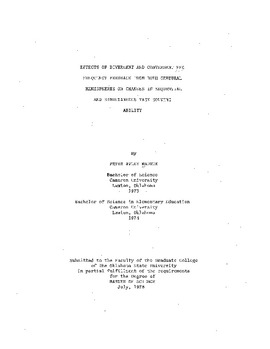| dc.description.abstract | The effect of relative EEG feedback from both cerebral hemispheres on their somewhat unique cognitive modes offers a challenging and lmportant area of inquiry for the behavioral scientist. Individual preferences for problem solving techniques, vocational predilections and issues of learning disabilities are fields of research containing puzzles that may find a part of their answers with further exploration into the mechanisms of bilateral hemispheric task processing. This study reports investigation of a blend of two fairly well confirmed concepts: hemispheric asymmetry and biofeedback. The first is the notion that the left and right hemispheres of the human brain have differing modes of operation. They are specialized and yet complementary to each other. The left hemisphere has been shown in many laboratories to be most efficient with verbal-symbolic, discrete, and sequential types of task processing. The right hemisphere appears to be specialized for visual-spatial tasks. The second concept is that of the typically instrumented, closed-loop feedback training situation. Thus, auditory feedback, analogous to hemisphere-specific electrical brainwave frequencies, was provided within a program for biofeedback learning to determine effects on various types of mental task processing. The ill)plications of the general hypothesis may best be understood when phrased in the form of several questions: (a) If' a normal human subject receives reinforcing, discrete auditory feedback tones that are correlated moment-by-moment with given frequency levels of EEG, can the subject learn over a series of training sessions to produce or r�qn�css such :lctiv_LL.Y aL wlll and in a manner calculated to exert control over the feedback signals? (b) If the EEG frequencies are detected by hemispheric source, and resulting signals are fed back as intermi ttant sound to the left ear representing fluctuating frequencies of the left hemisphere and a separate tone to the right ear reflecting right hemisphere activity, can the subject learn to significantly alter the feedback tones at either ear? (c) Will learned control over the bilateral frequency production transfer to cognitive tasking situations wherein improvement in taslcprocessing is reflected as a correlate of hemispheric conditioning? While considering these questions, assume the following conditions arc met: (a) subjects to the experimental learning opportunities are females, developmentally and culturally adapted to hemispheric specialization; (b) a series of training sessions are conducted within an unchanging laboratory setting for each subject having the sole purpose of instrumentally shaping the subjects' ability to produce individually programmed levels of EEG frequencies; and (c) the frequencies each subject is trained to produce are those identified with certain hemisphere-specific cognitive processes, the modes disparate by the linear, verbal type processing of the left hemisphere versus the more gestalt, spatial type cognitive mode usually associated with processing by the right hemisphere. These questions and assumptions lead to the central purpose of this investigation; will the dependent variable -- group mean changes ln scores between the pre and post training tests by type task by type training -- be significant? Of secondary interest are the directions of score changes and the correlations between some measures of training success and amounts of score change. | |
